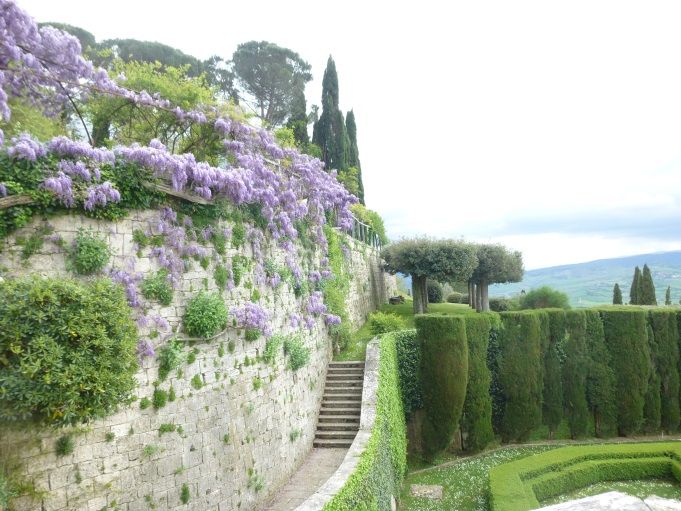May has arrived! In only a few weeks from the middle of April when buds unfold, to the beginning of May when il glicine (Wisteria sinensis) fully bursts forth with flowers, it appears on every fence and bower. It drips and dangles filling the air with a delicate fragrance attracting bees and butterflies. Native to North America and China, it blooms with profusion all over Umbria and Tuscany. The older ones have vines as big as tree trunks, the younger ones take off after only three years crawling along fences or over a pergola.
Wisteria in the garden at La Foce, Tuscany.

Wisteria and Rosemary blooming at L’Antica Vetreria, Piegaro, Umbria. (<= Colleen’s incredible vacation rental apartments! -ed.)
Wisteria along a village street and at the Circolo in Piegaro, Umbria.
A wild profusion of red swathes the fields and roadsides in Umbria in May. Papaveri, the red corn poppy (Papaver rhoeas) is almost a weed, blooming in the middle of wheat and alfalfa fields. In Roman myth, poppies were given as offerings to the dead, and in remembrance of the fallen in World War I, they are symbols of remembrance and peace. It is estimated that the wild poppy was domesticated in central Europe around 4,000 B.C. In our family, when our 6 year old grandson spotted all the poppies in the fields around Piegaro, he shouted, “Nonna, there’s fire in the fields!”
Poppies in an olive grove and in a field near Piegaro, Umbria.
Poppies beside Lago Trasimeno in Umbria.
We cannot forget the fauna among the flora arriving in May. Lumaca, or the common land snail (terrestrial pulmonate gastropod mulloscus) although beautiful, are a garden pest and will nibble a flower to shreds. The ancient Romans considered lumaca a gastronomic delicacy to be eaten at banquets. In Umbria, lumache (pl.) are prepared with a sauce of tomato marinara and eaten with gusto!
Brown garlic in oil, add tomatoes, parsley, basil, salt and pepper and cook over medium-low heat for 30 minutes, stirring frequently. Add the oregano and tomato paste; cook for 20 minutes. If sauce starts to thicken up, add a 1/2 cup of water, a little at a time, until the correct consistency is attained. Cook sauce for about 1 to 1-1/2 hours. Marinara sauce should be to the thinner side, not like the other tomato sauces.
Meanwhile, break up the chopped tomato as much as you can. About 20-25 minutes before the sauce is complete, add the snails, all at once. Increase the heat beyond simmer when the snails are added and keep the sauce just below the boiling point. Stir the snails occasionally during that time.
Serve in bowls with picks for the snails, and crusty Umbrian bread to sop up the marinara sauce.